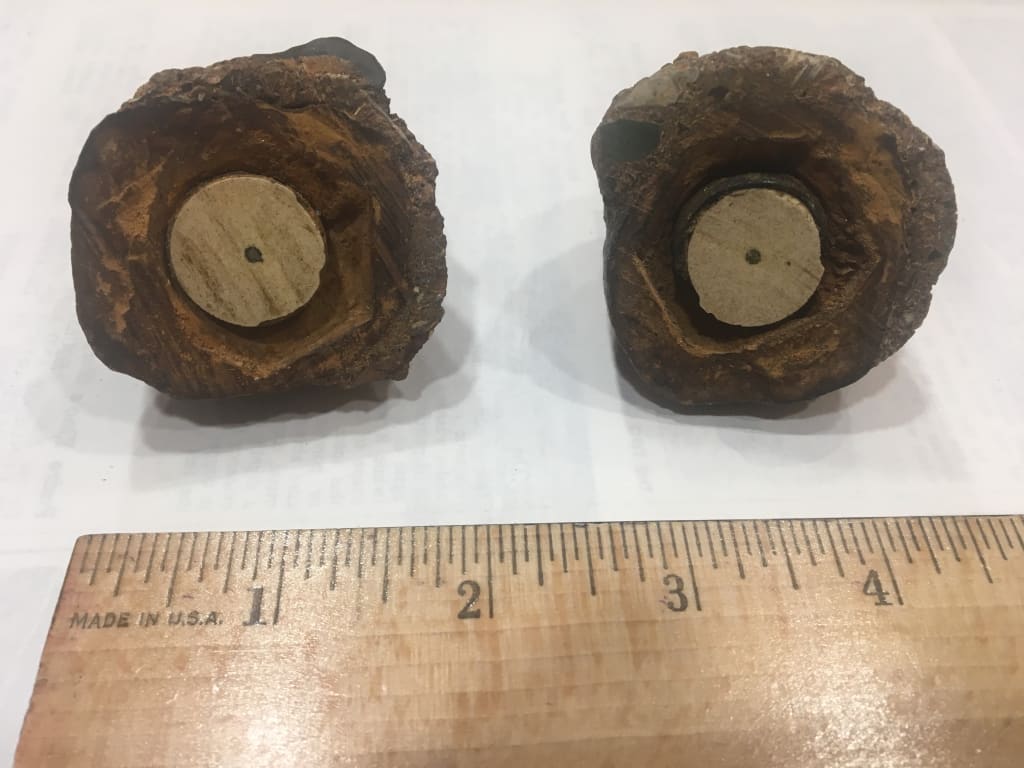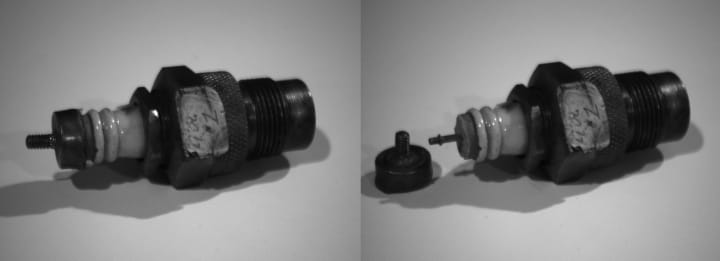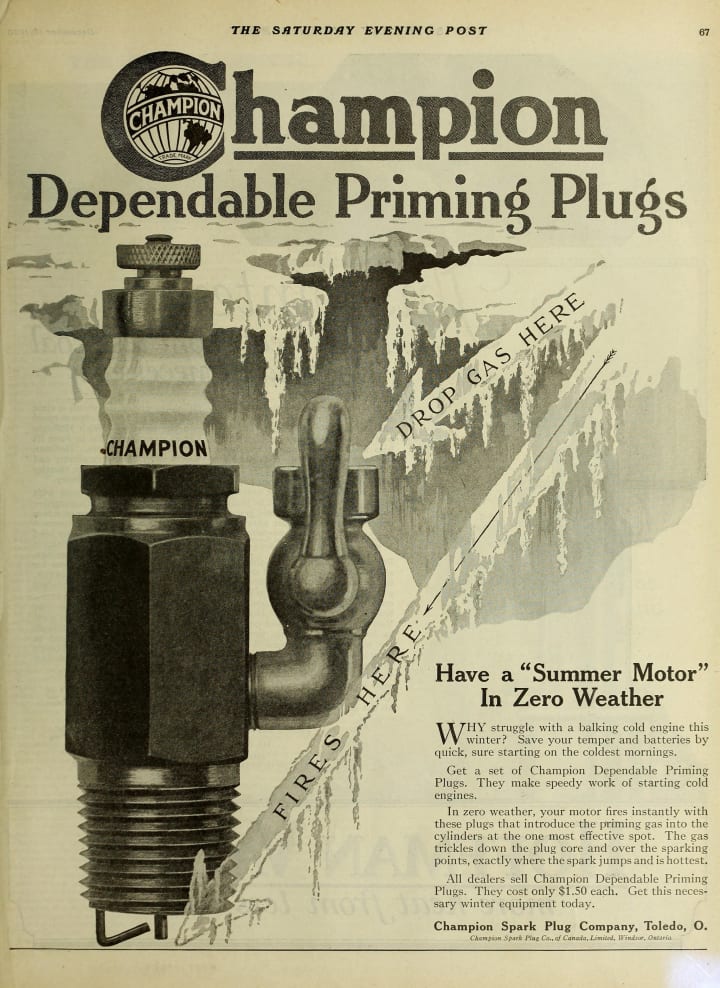
In 1961, three gem shop owners were prospecting in California when they found what they thought was a regular geode. Later, they cut it open and discovered that it contained a strange, man-made object that they could not identify.
There was much speculation on what the object was, or what purpose it could have served, until it was fairly conclusively identified as a spark plug. This identification did not stop the fringe believers, however, as it was claimed that the material encasing the artifact was dated as being 500,000 years old. Since spark plugs weren't invented until the 19th century, they claim that the Coso Artifact is an out-of-place artifact.
An out-of-place artifact is an object that is found out of context and challenges conventional historical chronology (usually by being "too advanced" for the civilization of the time or showing a human presence before humans were known to exist).
But what is the Coso Artifact? Is it really a spark plug? And if it is, then how did end up where it did?
THE DISCOVERY
On 13 February 1961, Wallace Lane, Virginia Maxey, and Mike Mikesell went looking for interesting specimens - geodes in particular - that they could sell at their store, LM&V Rockhounds Gem & Gift Shop in Olancha, CA. They spent the morning collecting rocks in an area about 6 miles northeast of Olancha before returning to the shop around lunchtime.
The next day, while processing the previous day's finds in the shop's workroom, Mikesell cut through what he thought was a geode and ruined an almost-new diamond saw blade in the process. Instead of finding the cavity one would expect of a geode, the cut nodule instead contained a perfectly circular section of very hard, white material that appeared to be porcelain. In the center of the porcelain cylinder was a 2-millimeter metal shaft that responded to magnets.
The hard porcelains cylinder was surrounded by some sort of casing, hexagonal in shape. Between this layer and the porcelain cylinder, there was a layer of decomposing copper. The outer clay or rock-like layer, which contained pebbles and fossil shell fragments, also contained two non-magnetic metallic objects that resembled a nail and a washer.
There is very little information available about the initial physical examination of the artifact. According to Maxey (1961), she consulted a geologist who, after examining the fossil shells encrusting the specimen, concluded that the nodule had taken at least 500,000 years to form. However, the identity of this geologist and the methods he used to come to this conclusion are unknown, and his findings were never published.
Other than its discoverers, creationist Ron Calais is the only named individual known to have physically inspected the artifact. He was allowed to both photograph and x-ray the object. The results can be seen here.
The x-ray of the bottom half of the object revealed no surprises. It showed a sheath of metal, presumably copper, covering the porcelain cylinder. The x-ray of the top half, however, seemed to show some sort of tiny spring or helix. INFO Journal [1] editor Ronald J. Willis (1969, as cited by Stromberg, 2000) speculated that the feature could be "the remains of a corroded piece of metal with threads."
Wallace Lane was the last known individual to have possession of the Coso Artifact. He had the object on display in his home but adamantly refused to allow anyone to examine it. He did, however, have a standing offer to sell it for $25,000.
In September 1999, a national search to contact Lane, Maxey, or Mikesell proved futile. It is suspected that Lane is dead. Maxey is alive, but avoiding any public comment. Mikesell's whereabouts are unknown.
The current location and disposition of the Coso Artifact are unknown.
THE SPECULATION
Since its discovery, many have speculated on the origin and possible uses of the Coso Artifact.
Maxey herself has speculated that the specimen may have been no more than 100 years old, stating that it could have been deposited in a mud bed and sun-baked. However, she has also apparently claimed that it could be "an instrument as old as Mu or Atlantis. Perhaps a communication device or some sort of directional finder or some sort of instrument made to utilize power principles we know nothing about" (Steiger, 1974, as cited by Stromberg, 2000).
Willis theorized that the artifact was some sort of spark plug. His brother, who co-edits INFO Journal, was astounded by the suggestion. "I was thunderstruck," he wrote, "for suddenly all the parts seemed to fit. The object sliced in two shows a hexagonal part, a porcelain or ceramic insulator with a central metallic shaft - the base components of any spark plug" (Willis, 1969, as cited by Stromberg, 2000).
However, they had difficulty reconciling the upper end featuring any sort of spring, helix, or metal threads with any contemporary spark plug.
The internet, of course, offers an abundance of unlikely theories.
Brian Wood, who describes himself as "Co-Producer, ParaNet UFO Continuum [and] International Director of MICAP" [2], suggested that if the object is not a spark plug, "My guess would be some sort of antenna. The construction reminds me of modern attempts at superconductors" (Wood, 1999, as cited by Stromberg, 2000).
Some have speculated that the artifact looks similar to a small capacitor with several different materials, while others theorize that it is evidence of a hyper-advanced civilization or time travel. And, of course, the ancient alien theorists have to weigh in on the matter, claiming that it could be a part of an extraterrestrial craft that visited Earth 500,000 years ago.
Numerous creationists have been involved with the story of the Coso Artifact since its discovery. Calais, one of the few to have physically examined the artifact, is an active contributor to creationist literature.
Donald Chittick, an adjunct faculty member of the Institute for Creation Research, has heavily promoted the Coso Artifact. In The Puzzle of Ancient Man, Chittick (1997, as cited by Stromberg, 2000) presumed that the artifact is an ancient spark plug and presented it as evidence that ancient civilizations were extremely advanced.
Chittick's work assumes that the artifact was found inside a naturally occurring geode, which would indicate that it is of great age, and therefore the spark plug qualifies as an out-of-place artifact. He argues that this refutes evolution, as such sophisticated technology during this time frame does not fit into current evolutionary models.
As far as geologic evidence is concerned, the most puzzling claim is that the artifact was encased in a geode.
Geodes are spherical rock structures composed of dense chalcedonic silica with an internal cavity lined with minerals. This mineral lining is often composed of tiny quartz crystals. The Coso Artifact possesses none of these characteristics. Just because the trio who discovered the artifact were searching for geodes on that day does not mean that there is any evidence that the artifact actually is one.
Maxey (1961) referred to the material encasing the object as "hardened" clay and noted that it had accrued a collection of pebbles and even a "nail and washer." This indicates that the material is not a rock but something much softer. Analysis of this surface material suggested a hardness of 3 on the Mohs scale, while chalcedony is a Mohs 6.5 -7.
The other argument made for the supposed age of the artifact is the presence of fossil shells on its surface. But, as we've just discussed, the softness of the surface and its tendency to collect debris makes the presence of fossil shells irrelevant.
THE REALITY
The most common theory put forth by fringe theorists is that the artifact is a spark plug, "designed and manufactured by an advanced civilization eons ago for technological devices equal to or surpassing our own" (Stromberg, 2000). As we've already covered, however, there is no evidence that the artifact is in any way "ancient."
Some more modern, realistic theories put forth the suggestion that the device could have been a modern spark plug, circa 1961. But ancient artifact theorists point to the supposed spring or helix mechanism found in the x-ray as an indication that this is not a spark plug.
Willis (1969, as cited by Stromberg) suggested that this confounding feature "is actually the remains of a corroded piece of metal with threads." The Willis brothers heavily suspected that the object was, in fact, a modern spark plug, but were unable to explain the strange feature shown in the x-ray. Spark plugs of the 1960s typically terminated with no visible threading and tapered to a dull point.
But, as Stromberg (2000) said: "Though many of the interested parties agreed that the artifact bore a striking resemblance to a 20th century spark plug, no one seemed to have considered the idea of evolution - specifically, spark plug evolution."
Pierre Stromberg, founder of Pacific Northwest Skeptics, and Paul V. Heinrich, geologist and Research Associate at Louisiana State University, investigated the origins of the Coso Artifact. They found that mining operations were conducted early in the 20th century in the area where the artifact was discovered. If internal combustion engines were used in these mining operations, they would have been very new technology at the time. It is logical to consider that spark plug technology would also have been as young.
Stromberg and Heinrich got in contact with the Spark Plug Collectors of America (SPCA) by sending letters to four different collectors. The letters described the artifact and included Calais's x-rays.
On 9 September 1999, Chad Windham, President of the SPCA, called Stromberg. It was so obvious to Windham that the artifact was a spark plug that, initially, he was convinced that Stromberg was a fellow collector trying to prank him. During this call, he identified the artifact as a 1920s-era Champion brand spark plug and later sent two identical spark plugs for comparison.
Ten days after that call, Bill Bond, founder of the SPCA and curator of a private spark plug museum with over 2,000 specimens, also called Stromberg and identified the artifact as a 1920s Champion spark plug. Collectors Mike Healy and Jeff Bartheld (VP of the SPCA) also concurred with this assessment and, to date, there has been no dissent among the spark plug collecting community as to the identity of the Coso Artifact.
The question of fraud always arises concerning the Artifact, since Windham mentioned the spark plug collectors enjoy pulling pranks on each other. But, there is little evidence that the original discoverers intended to deceive anyone or were ever affiliated in any way with the SPCA. The SPCA itself was not formed until 1975, well after the discovery of the artifact.
On 14 September 1999, Stromberg received the package containing two spark plugs from Windham, as well as an analysis of them. Windham wrote:
I am enclosing two spark plugs made by Champion Spark company circa 1920s. Plug #1 is 7/8" #18 thread. I have loosely assembled the plug, and chipped the "brass hat" off to show the configuration of it and the porcelain under it. Plug #2 is 1/2" NPT of same design.
The diameter of porcelain on Plug #1 is slightly less than 3/4" - close to the dimension in your letter. As you can see the base and packing nut which hold the porcelain, are sealed with a copper and asbestos gasket. This corresponds with the article. The center electrode of plugs were made of special alloys which were ". . . cut in two in 1961 but five years afterwards had no tarnishing visible." The sketches included clearly show one rib on the upper end of the porcelain, although Champion used two ribs in this era - probably just an artist's error. The "top hat" matches those of "plug 1 and 2."
As for the outer shell, it obviously decayed - probably from salt water (or other corrosive substance) and the outer crust is merely some sort of deposit like sea shells or other deposits collected on the deteriorating surface of the spark plug base.
There is no doubt that this is merely an old spark plug. Most probably, it is a Champion spark plug, similar to the two enclosed. (Stromberg, 2000)
The most striking part of Windham's letter was his description of a brass "top hat," which explained the mysterious metal threading that had so confounded previous attempts at identification.
This wasn't the only similarity between the artifact and the specimens Windham sent. Since he had chipped the brass top hat off of Plug #1, it clearly showed a metal shaft terminating in a flared end. This sort of flared end was also observed in the metal shaft of the Coso Artifact.

In the x-ray, the metal shaft of the Coso Artifact showed deterioration where it was exposed to the elements, just below the flare and above where it met the porcelain cylinder. This is consistent with what would be expected from an aging 1920s Champion spark plug.
All in all the specimens Windham sent are very similar to the original x-rays of the Coso Artifact. It should also be noted that the central shaft of both specimens respond to a magnet, just as with the artifact.
Proponents of various fringe theories regarding the artifact have pointed to the copper rings that encase the porcelain as being strange and mysterious. But Windham explained this as well. Plug #1 showed a pair of copper rings sandwiching an asbestos lining. According to Windham, porcelain and steel have vastly differing expansion rates. A design using copper rings and asbestos lining was utilized to compensate for some of the problems this caused.
Plug #2, although not disassembled by Windham, provided a clue as to why the Coso Artifact had not been identified decades before. Though suffering from severe tarnish, Plug #2 came with a top nut screwed into its top hat.

The majority of Champion's advertisements in the first half of the 20th century showed pictures of the spark plug with the top nut already screwed in place, obscuring the threads. This top nut came in two forms, one of which closely resembles the tip of modern spark plugs, which have no threading at all. So, it's apparent why modern investigators were unaware these spark plugs could have metal threads and were puzzled by their presence in the Coso Artifact.
As for the empty cavities within the artifact, these are where materials once resided before corroding away. As Stromberg (2000) states:
It should be noted that the corrosion of the Coso Artifact almost completely destroyed any of the iron-alloy-based components, except for the metal shaft encased in the porcelain cylinder. The samples received from Windham also revealed corrosion of the iron-based components, but the brass top hats were unscathed, except for some tarnishing. If the Coso Artifact is indeed a 1920s-era Champion spark plug, the x-ray of an almost perfectly preserved top hat is exactly what one would expect. Brass, a copper-zinc alloy, is commonly engineered to resist corrosion far better than iron-based alloys. In harsh environments, copper tends to outlast iron, but still succumbs fairly quickly. The rates of decay in the Coso Artifact match the rates of decay one would see in a 1920s-era Champion spark plug.
This process of corrosion was most likely hastened by corrosive mineral dust being blown off the dry lake bed of Lake Owen and onto the surrounding uplands where the Coso Artifact was discovered (Reheis, 1997, as cited by Stromberg, 2000).
THE SOLUTION
Thanks to the investigative work of the Willis brothers, Pierre Stromberg, Paul V. Heinrich, and the Spark Plug Collectors of America, we can pretty conclusively say that the Coso Artifact is, in fact, a 1920s Champion spark plug. It is encased in, not a geode, but an iron oxide nodule formed by corrosion. It was possibly used in the mining operations conducted in the Coso mountain range.
Stromberg (2000) said it best when he wrote:
To suggest that it was a device belonging to an advanced civilization of the ancient past could be interpreted as true, but only if we redefine "ancient" to mean "the early 20th century."
We can officially call the Coso Artifact debunked.
NOTES
[1] A pseudo-scientific journal published by The International Fortean Organization (INFO) that focuses on strange and unexplained phenomena.
[2] Multinational Investigations Cooperative on Aerial Phenomena
SOURCES
Chittick, D.E. (1997). The puzzle of ancient man. Oregon: Precision Graphics.
Coso artifact. (n.d.). Retrieved January 25, 2018 from http://rationalwiki.org/wiki/Coso_artifact
King, H.M. (n.d.). Geodes. Retrieved from http://geology.com/articles/geodes
Maxey, V. (1961). "The Coso geode." Letters from our readers. Desert Magazine of Outdoor Southwest, 25(5), 4. Retrieved from swdeserts.com/index_htm_files/196105-DesertMagazine-1961-May.pdf
Reheis, M.J. (1997). Dust deposition downwind of Owens (dry) Lake, 1991-1994: Preliminary findings. Journal of Geophysical Research, 102(D22), 25 999-26 008.
Steiger, B. (1974). Mysteries of time and space. Englewood Heights, NJ: Prentice-Hall.
Stromberg, P. (2000, May 31). The Coso Artifact. Retrieved from http://www.talkorigins.org/faqs/coso.html
Willis, R.J. (1969). The Coso Artifact. The INFO Journal, 1(4), 4-13.
Wood, B. (1999) [Untitled e-mail message]. Retrieved from http://www.ufonet.it/archivio/500000-year-old.htm
About the Creator
B. Jessee
Appalachian writer & nerd. Writes about the strangest bits of history and science as well as science news.
Enjoyed the story? Support the Creator.
Subscribe for free to receive all their stories in your feed. You could also pledge your support or give them a one-off tip, letting them know you appreciate their work.






Comments
There are no comments for this story
Be the first to respond and start the conversation.